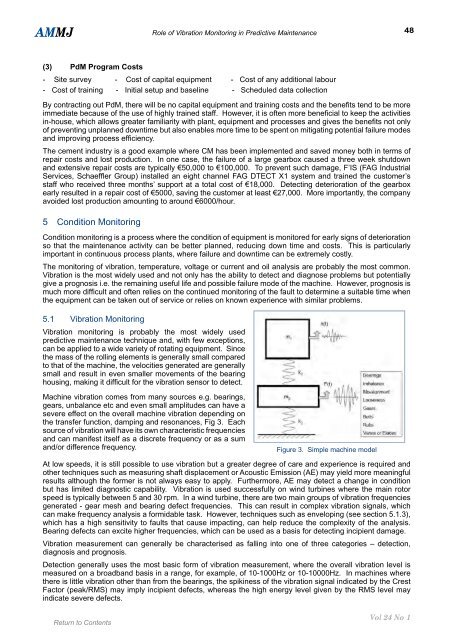AMMJ - Library
AMMJ - Library
AMMJ - Library
Create successful ePaper yourself
Turn your PDF publications into a flip-book with our unique Google optimized e-Paper software.
<strong>AMMJ</strong><br />
(3) PdM Program Costs<br />
- Site survey - Cost of capital equipment - Cost of any additional labour<br />
- Cost of training - Initial setup and baseline - Scheduled data collection<br />
By contracting out PdM, there will be no capital equipment and training costs and the benefits tend to be more<br />
immediate because of the use of highly trained staff. However, it is often more beneficial to keep the activities<br />
in-house, which allows greater familiarity with plant, equipment and processes and gives the benefits not only<br />
of preventing unplanned downtime but also enables more time to be spent on mitigating potential failure modes<br />
and improving process efficiency.<br />
The cement industry is a good example where CM has been implemented and saved money both in terms of<br />
repair costs and lost production. In one case, the failure of a large gearbox caused a three week shutdown<br />
and extensive repair costs are typically €50,000 to €100,000. To prevent such damage, F’IS (FAG Industrial<br />
Services, Schaeffler Group) installed an eight channel FAG DTECT X1 system and trained the customer’s<br />
staff who received three months’ support at a total cost of €18,000. Detecting deterioration of the gearbox<br />
early resulted in a repair cost of €5000, saving the customer at least €27,000. More importantly, the company<br />
avoided lost production amounting to around €6000/hour.<br />
5 Condition Monitoring<br />
Condition monitoring is a process where the condition of equipment is monitored for early signs of deterioration<br />
so that the maintenance activity can be better planned, reducing down time and costs. This is particularly<br />
important in continuous process plants, where failure and downtime can be extremely costly.<br />
The monitoring of vibration, temperature, voltage or current and oil analysis are probably the most common.<br />
Vibration is the most widely used and not only has the ability to detect and diagnose problems but potentially<br />
give a prognosis i.e. the remaining useful life and possible failure mode of the machine. However, prognosis is<br />
much more difficult and often relies on the continued monitoring of the fault to determine a suitable time when<br />
the equipment can be taken out of service or relies on known experience with similar problems.<br />
5.1 Vibration Monitoring<br />
Role of Vibration Monitoring in Predictive Maintenance<br />
Vibration monitoring is probably the most widely used<br />
predictive maintenance technique and, with few exceptions,<br />
can be applied to a wide variety of rotating equipment. Since<br />
the mass of the rolling elements is generally small compared<br />
to that of the machine, the velocities generated are generally<br />
small and result in even smaller movements of the bearing<br />
housing, making it difficult for the vibration sensor to detect.<br />
Machine vibration comes from many sources e.g. bearings,<br />
gears, unbalance etc and even small amplitudes can have a<br />
severe effect on the overall machine vibration depending on<br />
the transfer function, damping and resonances, Fig 3. Each<br />
source of vibration will have its own characteristic frequencies<br />
and can manifest itself as a discrete frequency or as a sum<br />
and/or difference frequency.<br />
Figure 3. Simple machine model<br />
At low speeds, it is still possible to use vibration but a greater degree of care and experience is required and<br />
other techniques such as measuring shaft displacement or Acoustic Emission (AE) may yield more meaningful<br />
results although the former is not always easy to apply. Furthermore, AE may detect a change in condition<br />
but has limited diagnostic capability. Vibration is used successfully on wind turbines where the main rotor<br />
speed is typically between 5 and 30 rpm. In a wind turbine, there are two main groups of vibration frequencies<br />
generated - gear mesh and bearing defect frequencies. This can result in complex vibration signals, which<br />
can make frequency analysis a formidable task. However, techniques such as enveloping (see section 5.1.3),<br />
which has a high sensitivity to faults that cause impacting, can help reduce the complexity of the analysis.<br />
Bearing defects can excite higher frequencies, which can be used as a basis for detecting incipient damage.<br />
Vibration measurement can generally be characterised as falling into one of three categories – detection,<br />
diagnosis and prognosis.<br />
Detection generally uses the most basic form of vibration measurement, where the overall vibration level is<br />
measured on a broadband basis in a range, for example, of 10-1000Hz or 10-10000Hz. In machines where<br />
there is little vibration other than from the bearings, the spikiness of the vibration signal indicated by the Crest<br />
Factor (peak/RMS) may imply incipient defects, whereas the high energy level given by the RMS level may<br />
indicate severe defects.<br />
48<br />
Vol 24 No 1

















